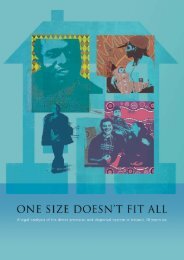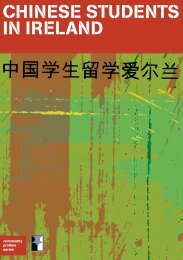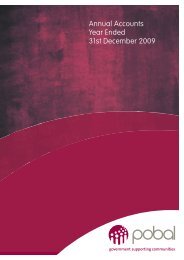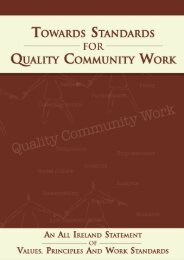Intercultural Education in the Post-Primary School - National Council ...
Intercultural Education in the Post-Primary School - National Council ...
Intercultural Education in the Post-Primary School - National Council ...
Create successful ePaper yourself
Turn your PDF publications into a flip-book with our unique Google optimized e-Paper software.
formal tests that can be employed <strong>in</strong>classroom-based assessment, such as oneto-one<strong>in</strong>terviews, student journals,students mak<strong>in</strong>g a presentation/demonstration, or observation of studentscomplet<strong>in</strong>g tasks and show<strong>in</strong>g certa<strong>in</strong>skills. For example, <strong>in</strong> one-to-one<strong>in</strong>terviews a teacher can ask a student toshow comprehension or knowledge us<strong>in</strong>gconcrete or visual stimuli, e.g. po<strong>in</strong>t to….,show me…. etc. Assessment throughobservation can be a useful way of see<strong>in</strong>g avariety of skills or aptitudes <strong>in</strong> action, e.g.<strong>in</strong>terpersonal skills, team-work andcooperation skills, listen<strong>in</strong>g skills, problemsolv<strong>in</strong>gskills, technical skills etc. However,care should be taken not to misunderstandcultural traits. For example, if a student isnot actively <strong>in</strong>volved <strong>in</strong> group-work thismight simply be due to <strong>the</strong> fact that activelearn<strong>in</strong>g is not a familiar method oflearn<strong>in</strong>g <strong>in</strong> <strong>the</strong> student’s country of orig<strong>in</strong>.Assessment for learn<strong>in</strong>gRecent advances <strong>in</strong> our knowledge of howlearn<strong>in</strong>g takes place and how learnersmake <strong>the</strong>ir way through classroomactivities have led to new understand<strong>in</strong>gsof <strong>the</strong> importance of assessment <strong>in</strong> <strong>the</strong>promotion of learn<strong>in</strong>g. Some of thisresearch is of particular <strong>in</strong>terest for<strong>in</strong>tercultural education as <strong>the</strong> focus <strong>in</strong>assessment activity beg<strong>in</strong>s to move from anemphasis on <strong>the</strong> assessment of learn<strong>in</strong>g to<strong>in</strong>clude assessment for learn<strong>in</strong>g; provid<strong>in</strong>gfeedback to learners on how to improve<strong>the</strong>ir learn<strong>in</strong>g and familiaris<strong>in</strong>g <strong>the</strong>m witha range of assessment methods andassessment vocabulary <strong>in</strong> a positive way.Assessment for learn<strong>in</strong>g and assessment oflearn<strong>in</strong>g are not oppos<strong>in</strong>g or contradictorypractices. While <strong>the</strong> assessment of learn<strong>in</strong>gwill always have a place <strong>in</strong> education and<strong>in</strong> classroom and school practice, <strong>the</strong>development of assessment for learn<strong>in</strong>goffers new opportunities for teachers.This approach has been particularlysuccessful <strong>in</strong> improv<strong>in</strong>g <strong>the</strong> motivation andperformance of students, <strong>in</strong>clud<strong>in</strong>gexam<strong>in</strong>ation performance (William andBlack), who were not achiev<strong>in</strong>g to <strong>the</strong>irpotential. It is an approach that may alsobenefit students com<strong>in</strong>g from diversecultural and l<strong>in</strong>guistic backgroundsbecause of its emphasis on <strong>the</strong>teacher/student review<strong>in</strong>g learn<strong>in</strong>g toge<strong>the</strong>r,<strong>the</strong> belief that every pupil can improve, <strong>the</strong>build<strong>in</strong>g of self-esteem, and <strong>the</strong> provisionof ongo<strong>in</strong>g feedback and encouragement.Fur<strong>the</strong>rmore, assessment for learn<strong>in</strong>genables teachers to assess and recognise adiverse range of achievements so that alllearners can have efforts recognised.This approach is also useful <strong>in</strong> assess<strong>in</strong>g<strong>the</strong> prior skills and learn<strong>in</strong>g of newcomersto a class. It enables teachers to establishprior learn<strong>in</strong>g <strong>in</strong> a way that is positive andnon-judgmental and <strong>the</strong> focus is on mov<strong>in</strong>g<strong>the</strong> new student forward to develop newskills and learn<strong>in</strong>g.For more on assessment for learn<strong>in</strong>g seewww.ncca.ie/junior cycle review.The ma<strong>in</strong> features of assessment oflearn<strong>in</strong>g and assessment for learn<strong>in</strong>g are setout opposite.96<strong>Intercultural</strong> <strong>Education</strong> <strong>in</strong> <strong>the</strong> <strong>Post</strong>-<strong>Primary</strong> <strong>School</strong>
















